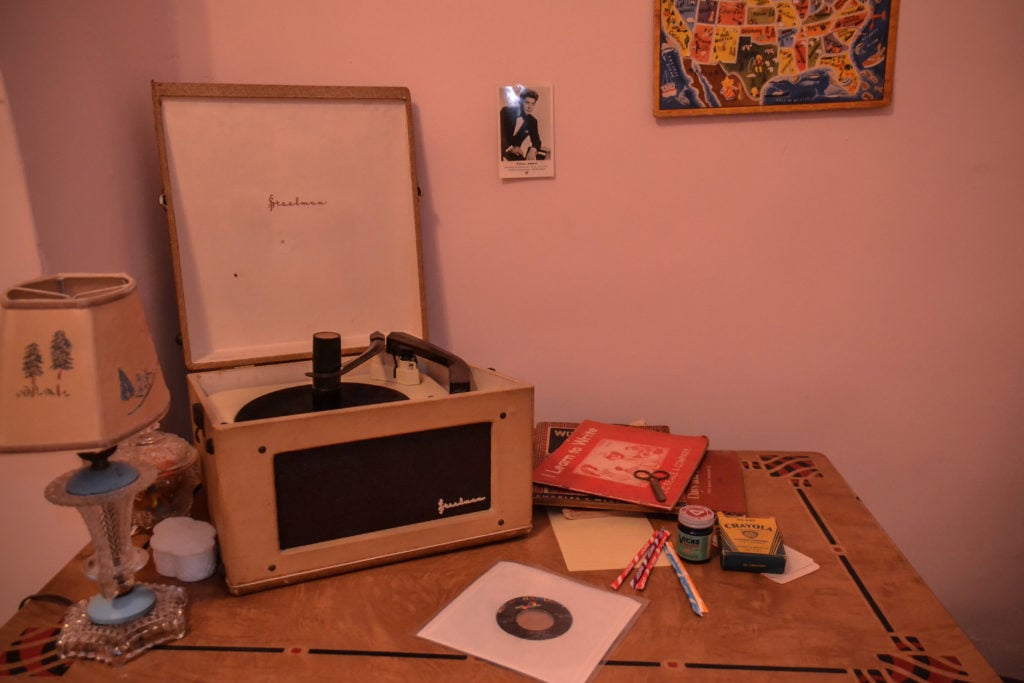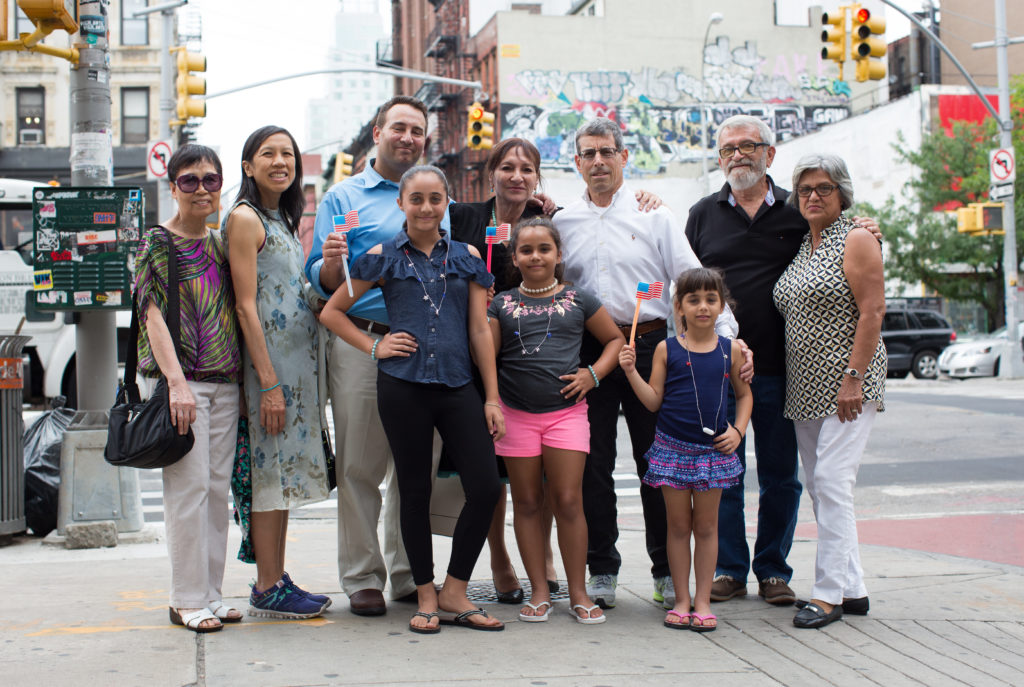Blog Archive
Ode to a Plastic Covered Couch
January 31, 2018

Coney Island has its Cyclone, the American Museum of Natural History its dinosaurs, MoMA its Picassos. At the Tenement Museum, what elicits thrills these days is the 1960s plastic-covered sofa and armchair in our recreation of Ramonita Rivera Saez’s parlor. The furniture serves as a paean to this sociable Puerto Rican garment worker, who raised her children (and helped raise her grandchildren), embraced the Catholic community at St Teresa’s, and—as “matriarch of the building”—welcomed successive waves of immigrant families to 103 Orchard Street.
Visitors exploring our recently opened Under One Roof exhibit revel in the memories evoked by the shiny squeakiness of this plastic-covered furniture: “My great aunt had a sofa like this!”; “My grandmother covered her furniture too!”; “This brings back memories.” Plastic-covered furniture resonates for Puerto Ricans, Jews and African Americans, as it does for Americans of Chinese, Irish, and Italian origin. Those seat covers are a common denominator of 1960s and 1970s American family life and identity.
Many Americans who took seats on plastic covered furniture understood how migrations shaped their families. Some were the children and grandchildren of Eastern and Southern Europeans who came in the late nineteenth and early twentieth centuries before being stopped by the 1924 race-based immigration quotas. Some were among the refugees brought in by the Displaced Persons and Refugee Act of 1948. Some were those whose families had undertaken migrations from one region of the United States to another, from Puerto Rico to New York, from North Carolina to Brooklyn, from Mississippi to Milwaukee. In 1965 Congress passed the Hart Celler Immigration Reform Act, lifting race-based quotas and bringing Civil Rights Era ideals to immigration policy, expanding the idea of who could become American and enabling Asians, Africans and others to take seats on plastic-covered furniture.
Under One Roof focuses on how three families—the Epsteins, Saez-Velezes, and the Wongs—started over at 103 Orchard. They found work in the garment industry and raised their children on a Lower East Side that had become one of the city’s most diverse neighborhoods. Their memories shed light on American identity and pluralism, its messiness and its beauty.
 Individual homes allowed families to maintain their distinct traditions even as they gave them the space to learn how to negotiate the cultural and linguistic barriers their migrations exposed. The same record player in the Epstein home played cantorial music for Kalman and Rivka, and Paul Anka hits for Bella. Seated on their plastic-covered couch, Ramonita’s boys did their English homework, but by the 1960s also watched Spanish language stations 41 and 47. The Wong children had a desk where they worked on their public school and Chinese school assignments; they also devoured Marvel comic books and enjoyed The Love Boat and Charlie’s Angels. In shared hallways families learned that being American was also about living with neighbors who came from other traditions. The three families experienced diversity daily through the cooking aromas emanating from airshafts, the foreign language conversations overheard in hallways, and the accented-English pleasantries they exchanged with neighbors in the stairway. Tenements schooled residents in shared living.
Individual homes allowed families to maintain their distinct traditions even as they gave them the space to learn how to negotiate the cultural and linguistic barriers their migrations exposed. The same record player in the Epstein home played cantorial music for Kalman and Rivka, and Paul Anka hits for Bella. Seated on their plastic-covered couch, Ramonita’s boys did their English homework, but by the 1960s also watched Spanish language stations 41 and 47. The Wong children had a desk where they worked on their public school and Chinese school assignments; they also devoured Marvel comic books and enjoyed The Love Boat and Charlie’s Angels. In shared hallways families learned that being American was also about living with neighbors who came from other traditions. The three families experienced diversity daily through the cooking aromas emanating from airshafts, the foreign language conversations overheard in hallways, and the accented-English pleasantries they exchanged with neighbors in the stairway. Tenements schooled residents in shared living.
Conflicts, tensions and insensitivities inevitably arose as families adapted to their new lives. Coming home after a long day of factory work, Ramonita couldn’t decipher PS 42’s English-only notices. Her son, Andy Velez, remembers Italian boys chasing him when he crossed Chrystie Street. Bella Epstein recalls how her Catholic friend and neighbor, Rosetta, abruptly told Bella her parents weren’t invited to a party because they were Jewish. In the fifth grade, Yat Chung Wong became “Kevin” when his teacher distributed a list of “American” names and instructed Chinese students to adopt one before the bell rang. On a larger scale, neighborhood conflicts over control of the schools and housing resources fell out along ethnic lines, exacerbating tensions.
Despite the tensions and misunderstandings that separated them, people also overcame differences to form crucial ties on a daily basis. Andy and Jose Velez joined a Little Italy Boy Scout troop that made Andy a leader. Jose honed his carpentry skills under the tutelage of an Amish teacher, and turned on Sabbath lights at neighborhood synagogues. Rosetta’s abrupt declaration of family prejudices did not dent the hours of playtime that bonded her and Bella. Bella also befriended Barbara, the African-American girl she met at the park who became her favorite checkers partner. Kevin Wong speaks admiringly of Ramonita, who moved beyond her Spanish-language comfort zone to use English and made welcoming conversation in the halls with Chinese families. As well, the Velez brothers recall how neighbors brought them red envelopes and pastries on the Chinese New Year.

from left to right: the Wongs, the Epsteins, and the Saez-Velezes on Orchard Street. Photo by Julie Stapen Photography
As our country debates immigration, we still have much to learn from the tenements, and how our own daily experiences, and those of our ancestors, help shed light on an American identity that is dynamic and complex. Living under one roof and being part of a diverse country is not easy: its messiness and complexities demand constant discussion, negotiation and reflection. The Epstein, Velez and Wong children and grandchildren became nurses, doctors, soldiers, contractors, teachers, IT directors, lawyers, school administrators, and government employees, experiencing moderate economic mobility. Though they’ve left 103 Orchard, they’ve kept its lessons, cherishing an American identity that encompasses people of all backgrounds, religious and skin colors. They remind us that the American Dream has always been as much a spiritual as a material quest, a hope that our strength as a nation derives from the experience of people of all backgrounds living among one another.
We invite you to take a seat on Ramonita’s plastic covered sofa, and consider how your family stories contribute to our country’s ever evolving identity.